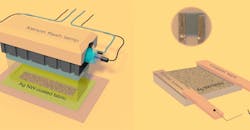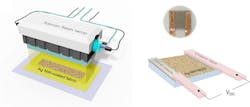Fused Nanowires and Conductive Fabric Heat the Body, Not the Area
The quest for energy efficiency sometimes involves thinking outside the box, or at least outside the body. For example, the obvious way to keep a person warm is to heat the space that they occupy, but this wastes power, of course. Wouldn’t it make more sense just to heat the person rather than the entire space?
One way to do this is via flexible, electrically powered heating patches sewn into the clothes. A team of engineers at Rutgers University and Oregon State University (OSU) have developed a cost-effective way to make thin, durable patches with heating performance that they maintain is nearly 70% higher than similar patches created by other technique.
The project, which is supported by grants from the National Science Foundation and the Walmart Manufacturing Innovation Foundation, hopes to result in garments that offer significant personal-heating energy savings. Their detailed technical paper published in Nature’s Scientific Reports, “Rapid Pulsed Light Sintering of Silver Nanowires on Woven Polyester for personal thermal management with enhanced performance, durability and cost-effectiveness,” references another study that claims “47% of global energy today is spent on indoor heating and nearly 42% of this energy is wasted to heat empty space and inanimate objects rather than humans.”
Key to their process is use of Intense Pulsed Light (IPL) sintering to fuse silver nanowires to patches of woven polyester fibers (Fig. 1). IPL sintering isn’t the only way to achieve the fusing objective, but it appears to yield a superior outcome.
1. Shown is a schematic of the IPL sintering system for silver nanowire-fabrics (a); the silver nanowire-fabric with silver-paste copper tape (b) is attached to the fabric using silver paste, providing the electrical path for applying dc voltage and measuring resistance of the fabric patch.
For example, one technique uses a fabric coating of graphene and carbon nanotubes, which have inherently high electrical conductivity and flexibility. However, these nanomaterials maintain high sheet resistance after deposition (100 to 1000 Ω/sq) because the electrical resistance of the junction between the deposited nanomaterials is typically quite high. This results in low thermal performance during joule heating.
To overtime this limitation, complex chemical-processing steps or high-temperature annealing is needed, which in turn can damage the underlying fabric. Compared to other techniques for nanowire fusing, the 300-μs IPL-based sintering also resulted in 30% reduction in electrical resistance, and greater durability (under bending up to 2-mm radius of curvature, washing, humidity, and high temperature), with only 50% additional nanowire mass compared to available alternative approaches.
Use of silver (Ag) for the nanowires is an attractive feature because silver is less expensive than gold and more stable against corrosion and oxidation than copper. Further, if the average inter-nanowire spacing is smaller than the wavelength at which the body radiates heat (≈9 μm), then the silver nanowire-coated-fabric also reduces thermal losses from the body, while retaining fabric breathability due to porosity of the nanowire network. Finally, silver nanowire networks also have antibacterial and UV-blocking properties.
Sintering or annealing of the deposited nanowires results in fusion at the nanowire contact points and is an alternative way to reduce electrical resistance without increasing the nanowire mass used. This can be accomplished via laser sintering, plasma processing, and electron-beam processing. However, these techniques are limited by their low throughput, high complexity, and fabrication issues (such as the need for vacuum conditions). Of course, sintering also can be done using an oven, but doing so subjects the coated fabric to high temperatures for relatively long durations (typically 100°C for three minutes), which can damage the fabric.
In the Rutgers/OSU approach, the silver nanowires are deposited on the fabrics using a “simple” dip-and-dry method. The team varied the number of dip-coating cycles to investigate the effect of added nanowire mass on the performance of the patch. The xenon-lamp IPL has a relatively large optical-coverage footprint—here, at least 12 inches (30 cm) × 1 inch (2.5 cm)—which is efficient for the larger fabric patches often needed.
Part of the project involved varying the IPL irradiance and pulse duration (in addition to the nanowire dimensions) to identify the optimum parameters to minimize the electrical resistance of the patch. The rationale for doing this was to determine where the improvement asymptote was reached. Also note that excessive irradiance and pulse duration can actually reduce conductivity, due to evaporation of the silver nanowires along with initiation of counterproductive interwire cracks.
They used a xenon lamp energized from 2 to 3 kV corresponding to irradiance of 6 to 16 kW/cm2, with pulse durations of 100 to 500 μs and corresponding fluence (radiant energy received by a surface per unit area) of 0.59 to 7.85 J/cm2. The optimal IPL sintering parameters for their “Dip-5” set of samples were 10-kW/cm2 irradiance and 300-μs duration (fluence of 3.04 J/cm2), which yielded the lowest resistance of 0.46 Ω/sq.
2. The Joule heating test for the fabricated silver nanowire-fabric patch shows the average temperature profile of the silver nanowire-fabrics with an applied 1-V source (a) and the average temperature response of optimally sintered Dip-5 patches over ten on/off cycles (at 2 minutes on/2 minutes off state) again at 1 V (b). The heating and cooling response and the maximum saturation temperature show high repeatability, indicating high thermal stability of the IPL-sintered patches under cyclic operation.
IPL-based sintering enhanced the Joule heating by enabling an increase in the ΔT of nearly 10°C (26 to 30% increase) at a specified drive voltage (Fig. 2). The 32°C maximum value for ΔT is quite close to the value of 35°C required for personal heating patches on garments cited in the paper’s references.



